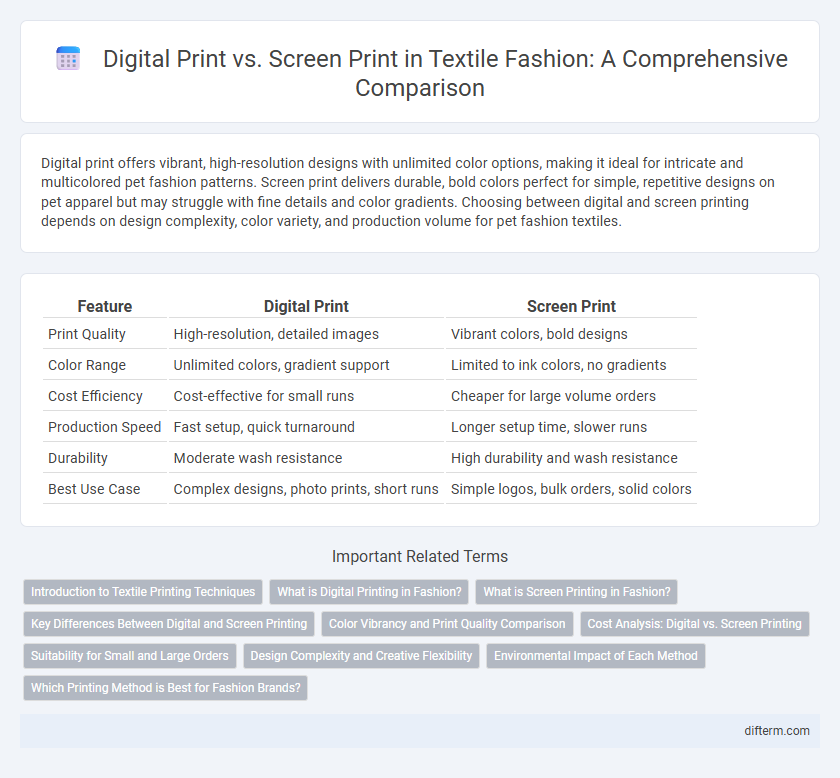Digital print offers vibrant, high-resolution designs with unlimited color options, making it ideal for intricate and multicolored pet fashion patterns. Screen print delivers durable, bold colors perfect for simple, repetitive designs on pet apparel but may struggle with fine details and color gradients. Choosing between digital and screen printing depends on design complexity, color variety, and production volume for pet fashion textiles.
Table of Comparison
| Feature | Digital Print | Screen Print |
|---|---|---|
| Print Quality | High-resolution, detailed images | Vibrant colors, bold designs |
| Color Range | Unlimited colors, gradient support | Limited to ink colors, no gradients |
| Cost Efficiency | Cost-effective for small runs | Cheaper for large volume orders |
| Production Speed | Fast setup, quick turnaround | Longer setup time, slower runs |
| Durability | Moderate wash resistance | High durability and wash resistance |
| Best Use Case | Complex designs, photo prints, short runs | Simple logos, bulk orders, solid colors |
Introduction to Textile Printing Techniques
Digital printing offers high-resolution, full-color designs directly onto fabrics using inkjet technology, ideal for complex patterns and small production runs. Screen printing employs stenciled screens to apply layers of ink, providing vibrant colors and durability suited for large volume orders. Choosing between digital and screen printing depends on factors like design complexity, fabric type, production scale, and cost efficiency in textile manufacturing.
What is Digital Printing in Fashion?
Digital printing in fashion involves directly applying designs onto textiles using advanced inkjet technology, allowing for high-resolution, full-color images with intricate detail. This method offers greater flexibility for small runs, customization, and rapid production compared to traditional screen printing. Digital printing supports sustainable practices by reducing water usage and minimizing waste through precise ink application.
What is Screen Printing in Fashion?
Screen printing in fashion is a popular textile printing technique that uses a mesh screen to transfer ink onto fabric, creating vibrant and long-lasting designs. This method allows for precise application of ink layers, making it ideal for bold graphics and multi-colored patterns on garments like t-shirts, hoodies, and bags. Renowned for its durability and color intensity, screen printing remains a favored choice in the fashion industry for high-quality custom apparel production.
Key Differences Between Digital and Screen Printing
Digital printing offers high-resolution, full-color designs with the ability to easily customize each print, making it ideal for small runs and complex patterns. Screen printing involves applying ink through a mesh stencil, delivering vibrant colors and durability suited for bulk production and simple designs. Cost-effectiveness favors digital printing for limited quantities, while screen printing lowers per-unit cost at scale, reflecting core differences in production efficiency and design flexibility.
Color Vibrancy and Print Quality Comparison
Digital print offers superior color vibrancy with the ability to reproduce intricate designs and a wide spectrum of hues directly onto fabric, ensuring high-resolution detail and smooth gradients. Screen print excels in durability and opacity, producing vivid, long-lasting colors by layering thick ink, ideal for bold, solid patterns on textiles. Both methods deliver distinct advantages in print quality, with digital printing favored for photographic precision and screen printing preferred for intense, saturated colors on durable garments.
Cost Analysis: Digital vs. Screen Printing
Digital print offers lower upfront costs due to minimal setup requirements, making it ideal for small to medium production runs with complex designs. Screen printing involves higher initial expenses for screens and setup but becomes cost-effective in large volume orders due to lower per-unit costs. Evaluating the break-even point between digital and screen printing depends on quantity, design complexity, and fabric type, influencing the overall cost-efficiency for fashion brands.
Suitability for Small and Large Orders
Digital print excels in suitability for small orders due to its ability to produce detailed, high-resolution designs quickly without the need for extensive setup, making it cost-effective for limited runs. Screen print is more efficient for large orders, as the initial setup cost is offset by lower per-unit costs and consistent color vibrancy across bulk quantities. Both techniques offer distinct advantages depending on order size and project requirements in textile printing.
Design Complexity and Creative Flexibility
Digital print offers superior design complexity and creative flexibility by enabling intricate patterns, gradients, and unlimited color variations without additional setup costs. Screen print excels in producing bold, vibrant designs with high durability but is limited by the number of colors and requires separate screens for each hue, restricting design intricacy. For fashion brands seeking detailed artwork and quick turnaround, digital printing enhances creative freedom, whereas screen printing suits simpler, high-volume designs with strong color opacity.
Environmental Impact of Each Method
Digital printing on textiles uses less water and produces fewer chemical wastes compared to traditional screen printing, making it a more eco-friendly option. Screen printing involves the use of large volumes of inks and solvents, often resulting in significant water pollution and higher energy consumption due to multiple drying steps. Sustainable fashion brands increasingly prefer digital print technology to reduce their carbon footprint and minimize environmental damage during fabric decoration.
Which Printing Method is Best for Fashion Brands?
Digital print offers unmatched color versatility and quick turnaround, making it ideal for fashion brands aiming for small-batch, customizable designs with intricate details. Screen print excels in durability and cost-efficiency for large-volume production, delivering vibrant, long-lasting colors on fabrics like cotton and polyester. Fashion brands seeking high-quality, scalable, and sustainable textile printing often choose based on design complexity, order size, and fabric type to determine the most effective method.
Digital print vs Screen print (textile printing) Infographic

 difterm.com
difterm.com